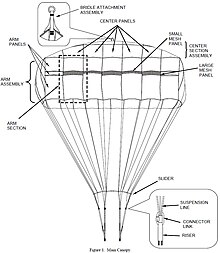
A parachute is a device used to slow the motion of an object through an atmosphere by creating drag or, in a ram-air parachute, aerodynamic lift. A major application is to support people, for recreation or as a safety device for aviators, who can exit from an aircraft at height and descend safely to earth.

A paratrooper is a military parachutist—someone trained to parachute into a military operation, and usually functioning as part of an airborne force. Military parachutists (troops) and parachutes were first used on a large scale during World War II for troop distribution and transportation. Paratroopers are often used in surprise attacks, to seize strategic objectives such as airfields or bridges.

Airborne forces are ground combat units carried by aircraft and airdropped into battle zones, typically by parachute drop or air assault. Parachute-qualified infantry and support personnel serving in airborne units are also known as paratroopers.

The 82nd Airborne Division is an airborne infantry division of the United States Army specializing in parachute assault operations into denied areas with a U.S. Department of Defense requirement to "respond to crisis contingencies anywhere in the world within 18 hours". Based at Fort Bragg, North Carolina, the 82nd Airborne Division is part of the XVIII Airborne Corps. The 82nd Airborne Division is the U.S. Army's most strategically mobile division.

High-altitude military parachuting, or military free fall (MFF), is a method of delivering military personnel, military equipment, and other military supplies from a transport aircraft at a high altitude via free-fall parachute insertion. Two techniques are used: HALO and HAHO.
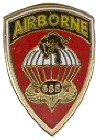
The 555th Parachute Infantry Battalion, nicknamed The Triple Nickles, was an all-black airborne unit of the United States Army during World War II.
Treejumping is a form of parachuting, into a forest or jungle – typically, from a relatively low altitude. It is generally considered to be a particularly dangerous form of parachuting. Treejumping is also especially damaging to the parachuting equipment.

In military organizations, a pathfinder is a specialized soldier inserted or dropped into place in order to set up and operate drop zones, pickup zones, and helicopter landing sites for airborne operations, air resupply operations, or other air operations in support of the ground unit commander. Pathfinders first appeared in World War II, where they served with distinction, and continue to serve an important role in today's modern armed forces, providing commanders with the option of flexibly employing air assets.

The United States Army Airborne School – widely known as Jump School – conducts the basic paratrooper training for the United States Armed Forces. It is operated by the 1st Battalion (Airborne), 507th Infantry, United States Army Infantry School, Fort Benning, Georgia. The Airborne School conducts the Basic Airborne Course, which is open to troops from all branches of the United States Department of Defense, Reserve Officer Training Corps, and allied military personnel.

A static line is a fixed cord attached to a large, stable object. It is used to open parachutes automatically for paratroopers and novice parachutists.
A parachute rigger is a person who is trained or licensed to pack, maintain or repair parachutes. A rigger is required to understand fabrics, hardware, webbing, regulations, sewing, packing, and other aspects related to the building, packing, repair, and maintenance of parachutes.

The 505th Parachute Infantry Regiment, originally the 505th Infantry Regiment, is an airborne infantry regiment of the United States Army, one of four infantry regiments of the 82nd Airborne Division of the United States Army, with a long and distinguished history.

The 504th Infantry Regiment, originally the 504th Parachute Infantry Regiment, is an airborne forces regiment of the United States Army, part of the 82nd Airborne Division, with a long and distinguished history. The regiment was first formed in mid-1942 during World War II as part of the 82nd Airborne Division and saw service in Sicily, Italy, Anzio, the Netherlands, Belgium and Germany.

The United States Army Parachute Team, nicknamed the Golden Knights, is a demonstration and competition parachute team of the United States Army. It consists of demonstration and competition parachutist teams, drawn from all branches of the U.S. Army. Members must demonstrate excellence in parachuting.
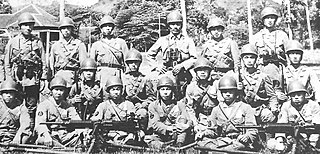
The Imperial Japanese Navy fielded naval paratroopers during World War II. The troops were officially part of the Special Naval Landing Forces. They came from the 1st, 2nd and 3rd Yokosuka SNLFs. The 2nd Yokosuka took no part in any airborne operations and became an island defensive base unit. They were under the operational control of the Imperial Japanese Navy Air Service. Rikusentai paratroopers should not be confused with the Imperial Japanese Army paratroopers, known as Teishin.
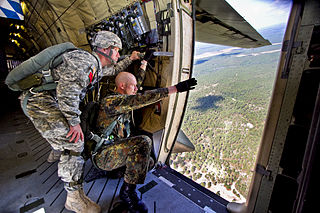
Jumpmasters are the expert paratroopers in an airborne unit who train and teach the military techniques for jumping from airplanes. They are responsible for training soldiers who enter Army Airborne School into paratroopers and managing airborne jump operations in airborne units across all branches of services.
The Basic Parachute Course for members of the British Armed Forces is conducted by the Parachute Training Squadron of the Airborne Delivery Wing, based at RAF Brize Norton.
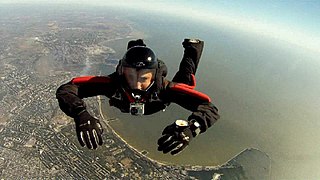
Parachuting, including also skydiving, is a method of transiting from a high point in the atmosphere to the surface of Earth with the aid of gravity, involving the control of speed during the descent using a parachute or parachutes.
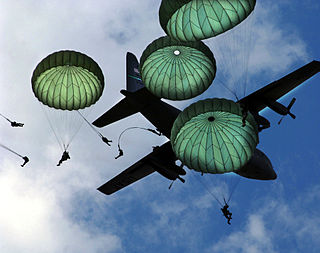
The T-10 Parachute is a series of static line-deployed parachutes used by the United States armed forces for combat mass-assault airborne operations and training. The T-10 parachute was introduced in the early 1950s. In 1976, the B model introduced the anti-inversion net; in 1986, the C model was introduced, which changed the pocket band free length from 4" to 7½". The T-10D, adopted in 2000, includes the detachable pack tray, which in itself includes the 15' universal static line and 5' extension static line. The T-10D is currently being replaced by the T-11 parachute system. In 2006, all T-10C parachutes were revised by adding one static line stow bar to each side of the pack tray; the material for the T-10C was also changed to the muddy water 407.
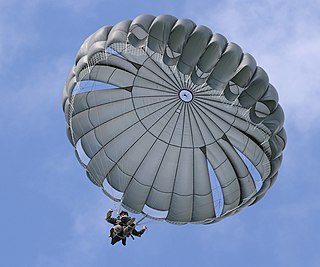
The MC-6 Parachute is a Maneuverable Canopy(MC) static line-deployed personnel parachute of the United States Armed Forces. Developed by United States Army Special Forces, the parachute has been used by American Special Operations Forces (SOF) beginning in 2006 and Australian SOF starting in 2011.

